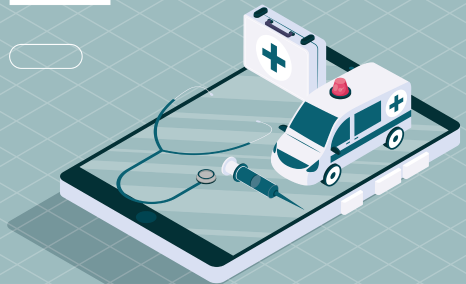Medical Radiation Detection Devices: Essential Tools in Healthcare and Diagnostics
Nov 20, 2024
Table of Contents
Medical radiation detection devices are not just safety tools; they are integral to maintaining the delicate balance between leveraging the benefits of radiation and minimizing its risks. With radiation playing a pivotal role in diagnosing and treating life-threatening conditions such as cancer, the need for precise monitoring is paramount.
These devices empower healthcare providers to deliver targeted treatments with confidence, ensure compliance with strict regulatory guidelines, and foster a culture of safety in high-radiation environments. As medical technology advances, radiation detection devices remain at the forefront of innovation, safeguarding both human health and technological progress.
Downloads
Article in PDF
Recent Articles
- The Revolution of Healthcare: Smart Medical Devices Transforming the Future
- Wireless Brain Sensors: Revolutionizing Neuroscience and Healthcare
- From Paper to Pixels: The Advantages and Challenges of Electronic Health Record
- Most Promising Applications of Artificial Intelligence (AI) in Healthcare Segment
- Mobile Clinics: Bridging the Healthcare Gap
Importance of Radiation Detection in Healthcare
Radiation detection in healthcare is vital for ensuring both patient and healthcare professional safety, as radiation plays a critical role in various diagnostic and therapeutic procedures. In diagnostic imaging, techniques such as X-rays, CT scans, and nuclear medicine rely on controlled exposure to ionizing radiation to capture detailed images of the body’s internal structures. Similarly, in cancer treatment, radiation therapy is used to target and destroy cancer cells. While these applications are invaluable, improper or excessive exposure to radiation can lead to severe health risks, such as radiation burns, tissue damage, and an increased risk of cancer. Radiation detection devices help mitigate these risks by monitoring and controlling exposure levels, ensuring that they remain within safe thresholds.
For healthcare professionals, radiation exposure can accumulate over time, leading to long-term health complications. By continuously monitoring radiation levels in clinical settings, detection devices help reduce the risk of occupational exposure, keeping medical staff safe from unnecessary radiation. Furthermore, radiation detection ensures that patients receive the appropriate dose of radiation needed for effective diagnosis or treatment without exceeding recommended limits. These devices are also essential in maintaining compliance with regulatory standards, such as those set by the International Atomic Energy Agency (IAEA), which oversees radiation safety protocols worldwide. In short, radiation detection is a cornerstone of modern healthcare, balancing the effective use of radiation with the imperative to protect both individuals and the environment.
Types of Medical Radiation Detection Devices
Medical radiation detection devices come in various forms, tailored for specific applications, ranging from personal exposure monitoring to high-precision medical equipment calibration. Below is a detailed breakdown of the major types of radiation detection devices commonly used in healthcare.
Dosimeters
Dosimeters are critical devices designed to measure accumulated radiation exposure over time, ensuring safety for both healthcare professionals and patients. These devices come in various forms, each suited for specific applications. Film badges use photographic film to record exposure levels, making them cost-effective and widely used in monitoring occupational radiation exposure. Thermoluminescent dosimeters (TLDs) capture radiation energy and release it as light when heated, offering higher accuracy and reusability. Modern electronic personal dosimeters (EPDs) provide real-time monitoring and digital readouts, enabling immediate awareness of exposure levels. Dosimeters are essential for maintaining safe practices in environments where ionizing radiation is prevalent, such as radiology departments and nuclear medicine facilities.
Geiger-Müller (GM) Counters
Geiger-Müller (GM) Counters are versatile and widely used radiation detection devices that detect and measure ionizing radiation. They operate by using a gas-filled tube that produces an electrical pulse when radiation interacts with the gas, making them highly effective for real-time monitoring. GM counters are particularly useful for detecting beta particles and gamma rays, though they are less sensitive to low-energy radiation. In medical settings, GM counters are commonly employed for general radiation surveys and to identify radioactive contamination on surfaces, equipment, or personnel. Their portability, ease of use, and ability to provide immediate feedback make them an essential tool in maintaining safety in environments where radiation is present.
Ionization Chambers
Ionization chambers are a key type of radiation detection device commonly used in medical settings. These devices measure the intensity of ionizing radiation by detecting the electrical charge produced when radiation ionizes the gas within the chamber. The ionized particles are collected by electrodes, creating a measurable current proportional to the amount of radiation present. Ionization chambers are particularly useful for calibrating radiological equipment and monitoring exposure in environments with higher radiation levels, such as during radiation therapy or in nuclear medicine facilities. Their ability to measure both low and high levels of radiation makes them an essential tool for ensuring accurate radiation delivery and maintaining safety standards in healthcare.
Scintillation Detectors
Scintillation Detectors are a vital type of medical radiation detection device, widely used for their sensitivity and accuracy in detecting ionizing radiation. These detectors operate by converting high-energy radiation into visible light, which is then captured by a photomultiplier tube and converted into an electrical signal. Scintillation detectors are commonly employed in nuclear medicine for imaging and diagnostic purposes, as well as in radiation therapy to monitor treatment delivery. Their ability to detect a broad range of radiation types, including gamma rays and X-rays, makes them versatile tools in healthcare settings. With advancements in scintillation materials and technology, these detectors continue to improve in terms of efficiency, allowing for more precise measurements and enhancing patient safety during medical procedures.
Radiation Survey Meters
Radiation Survey Meters are essential tools used to assess the environmental radiation levels in healthcare settings. These devices are designed to detect and measure the presence of ionizing radiation in a specific area, ensuring that the radiation levels remain within safe limits. Radiation survey meters are commonly used to monitor radiation around medical equipment, such as X-ray machines and radiation therapy devices, as well as in areas where radioactive materials are handled. By providing real-time measurements, these meters help healthcare professionals identify potential radiation hazards, prevent overexposure, and ensure compliance with safety regulations. Available in handheld or stationary models, radiation survey meters are vital for maintaining a safe working environment in medical facilities.
Advancements in Medical Radiation Detection
Recent advancements in medical radiation detection have significantly improved the accuracy, sensitivity, and efficiency of monitoring radiation exposure in healthcare settings. One of the key developments is the integration of digital technology, which has enhanced the functionality of radiation detection devices. Modern devices now feature real-time data collection and digital readouts, allowing healthcare professionals to instantly assess radiation levels and make informed decisions. This integration also enables the storage and remote access of radiation data, facilitating better tracking and reporting of exposure over time. Moreover, advancements in wireless technology have led to the creation of compact, wearable dosimeters that monitor radiation exposure without hindering a healthcare worker’s movement, providing continuous protection even in high-risk environments.

Another major advancement is the improvement in the sensitivity and precision of radiation detection materials. New detectors, such as high-performance scintillators and semiconductor detectors, offer greater accuracy in measuring low radiation doses, which is critical for both patient and worker safety. These advancements not only help in the detection of ionizing radiation but also play a vital role in optimizing radiation therapy. Additionally, the incorporation of artificial intelligence (AI) and machine learning into radiation detection systems has opened up new possibilities. AI algorithms can now predict potential radiation risks and automate adjustments during diagnostic or therapeutic procedures, reducing human error and ensuring more personalized care for patients. As technology continues to evolve, these innovations promise even more precise and efficient radiation monitoring, enhancing safety in medical environments.
Medical Radiation Detection Devices: Challenges and Limitations
One of the primary challenges facing medical radiation detection devices is their high cost. Advanced devices, such as scintillation detectors and wearable dosimeters, often come with a hefty price tag. This can be a barrier for smaller healthcare facilities or those in developing regions, limiting access to essential safety tools. While the devices offer long-term benefits by ensuring accurate radiation measurement and compliance with safety regulations, the initial investment and ongoing operational costs can be substantial.
Another significant challenge is the need for regular maintenance and calibration. To maintain their accuracy, radiation detection devices must undergo periodic checks and recalibration, which can be resource-intensive. This is particularly important for devices like ionization chambers and Geiger-Müller counters, where even slight discrepancies can lead to incorrect readings and compromise safety. For healthcare institutions, this translates to additional time, cost, and technical expertise required to ensure that the equipment remains reliable over time.

Furthermore, there are training requirements for both healthcare professionals and technicians to effectively use and interpret the readings from radiation detection devices. Inadequate training can result in improper use, leading to safety risks or inefficiencies. While many devices are becoming more user-friendly, the complexity of certain tools, particularly those used in nuclear medicine and radiation therapy, still necessitates specialized training. Ensuring that all staff are well-trained and aware of radiation safety protocols is an ongoing challenge for healthcare providers.
The Future of Radiation Detection in Medicine
The future of radiation detection in medicine is poised for significant innovation, driven by the evolving needs of healthcare providers and patients. As radiation therapy becomes more targeted and diagnostic imaging techniques advance, there is a growing demand for more accurate, real-time monitoring of radiation exposure. The global medical radiation detection devices market is estimated to grow at a CAGR of ~7% during the forecast period from 2024 to 2030, as per DelveInsight.
Moreover, the involvement of key companies such as Thermo Fisher Scientific Inc., Ludlum Measurements, Inc., Mazur Instruments, S.E. International, Inc, SOEKS USA, Sullivan Street, Danaher, ADM Systems, UAB Polimaster Europe, Canon Inc, HÖRMANN, Mirion Technologies, Inc., Varex Imaging, LND, INC, LAURUS Systems, Spectrum Techniques, LLC., Berthold Technologies GmbH & Co.KG, Baltic Scientific Instruments, Zecotek Photonics Inc., HAMAMATSU PHOTONICS K.K., and others are also playing a crucial role in driving the medical radiation detection devices market.

Emerging technologies, such as the integration of Internet of Things (IoT) capabilities, promise to revolutionize radiation detection by enabling devices to wirelessly communicate with hospital networks. This would allow for centralized monitoring of radiation levels across multiple departments, ensuring immediate responses to safety concerns. Additionally, machine learning and artificial intelligence are expected to play a major role in automating radiation dose adjustments, improving the precision of treatments, and enhancing predictive analytics to prevent overexposure.
Nanotechnology is another frontier that holds great promise for the future of radiation detection. The development of miniature, highly sensitive radiation detectors could lead to more portable, wearable devices that provide continuous monitoring with minimal disruption to a patient’s or healthcare worker’s routine. These advancements could allow for personalized radiation protection, tailored to individual exposure levels, and enable healthcare facilities to offer more adaptive and precise care.
With the increasing focus on patient safety, regulatory bodies are likely to demand higher standards for radiation monitoring, encouraging the development of devices that not only meet but exceed current safety thresholds. As these technologies continue to evolve, radiation detection devices will become more integrated into everyday medical practice, ensuring both safety and efficacy in radiation-based diagnostics and therapies.

Downloads
Article in PDF
Recent Articles
- Evaluating the Essential Factors Building the Value-Based Healthcare Model
- COVID-19 crisis can prove to be a catalyst for Artificial Intelligence in Healthcare
- Opioid-Induced Respiratory Depression: Unveiling the Silent Threat
- Most Promising Applications of Artificial Intelligence (AI) in Healthcare Segment
- How Artificial Intelligence is adding value to the Healthcare sector



